By A Wahab Siyal, Bashir Ahmad, Irfan Ali and Tariq Mustafa
A recent initiative undertaken by the Pakistan Agricultural Research Council (PARC) team to explore micro-hydropower systems proved both interesting and informative for the team. To cope with the impacts that climate change has had on resource-poor communities, the HI-AWARE-PARC team had been thinking of developing micro-hydropower systems that would improve the people’s livelihoods.
Micro-hydropower systems can generate 5-100 KW of electricity. In addition to other RC-3 activities, like working with solar power technology and highly efficient irrigation systems, the team wanted to select new sites piloting existing adaptation measures. The team has been keen to introduce small micro-hydropower systems and other initiatives like solar and biogas projects.
Climate Change, Alternate Energy and Water Resources Institute (CAEWRI) aim to introduce micro-hydropower system on rivers/canals/channels as well as in streams in hilly terrains for generating electricity and for pumping irrigation water with different approaches, which fit HI-AWARE’s objectives.
Visit to a micro-hydropower company
To learn more about the science of micro hydropower, the team travelled to the city of Mardan, in KPK province, because we had been told that a small company in Mardan, with the proper infrastructure and facilities, has been manufacturing micro turbines.
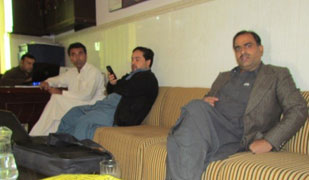 Meeting with the factory owner in Mardan. Meeting with the factory owner in Mardan.
|
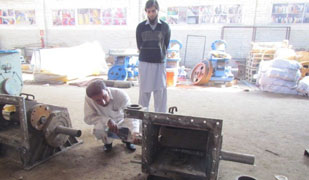 Observing various processes and parts of micro-turbines in the factory. Observing various processes and parts of micro-turbines in the factory. |
The team spent around six hours in the company’s workshop and on the field as well, where we observed and documented a micro-turbine in operation. It was a great opportunity for us to learn about the advantages and limitations of micro turbines. We discussed various design aspects of micro-turbines and their technical specifications. The manufacturers also shared their stories of successes and failures on their journey toward establishing themselves as an independent entity.
Around 1,300 micro-hydropower systems have been installed in the northern areas of Pakistan, through NGOs, government agencies and private communities. The KPK government has some major micro hydropower projects in the pipeline, which have been reflected in the government’s new policy.
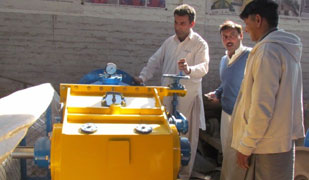 | 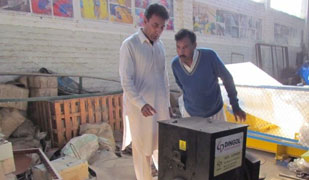 |
In-depth discussion about different types and designs of available micro-turbines in the factory.
Visit to the micro-hydro system’s operation site
The manufacturers took us to their micro-hydropower operation site, which was about an hour’s drive away from Mardan. During the field visit, we were also able to witness how the community regarded the micro hydropower setup. Besides providing us insight and information regarding the project’s technical details, the visit also allowed us to understand its social and financial aspects. These insights were valuable because the community perspective will be very important in creating guidelines for HI-AWARE-PARC projects in the future.
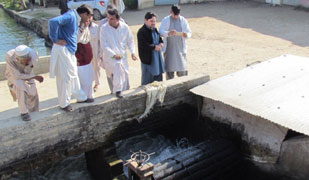 On-site visit of the micro-hydro turbine. On-site visit of the micro-hydro turbine. | 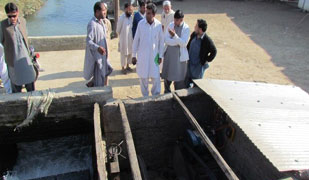 Interaction with the local community. Interaction with the local community. |
 A complete view of the micro-hydro system installed in a water channel. A complete view of the micro-hydro system installed in a water channel. | 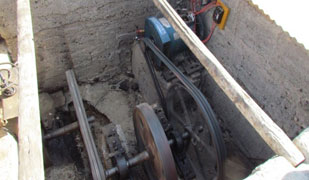 The gear-pulley system of the turbine. The gear-pulley system of the turbine. |
During the site visit, we travelled along the channel and observed many artificial falls of 5 – 10 ft drops that had been create by the irrigation department to offset the natural topography of the land.
But while there is huge potential for installing many more turbines on this channel, which has sizable populations residing close to both sides of the structure, only one micro-hydro system had been installed on the channel. One micro-hydro system, of 20 KW capacity, on the channel had been installed privately by the local community, with their own limited resources.
Livelihoods improved by the micro-hydropower system
This turbine’s 20 KW of electricity is used to run a flour mill and a saw machine, and it provides 100 percent of the electricity needs for eight commercial shops. The community is very aware of the benefits provided by the system and have a sense of ownership regarding what they have accomplished. Owing to financial constraints they used some second hand parts for the generator and pulley shafts in the micro-hydropower system, and thus to some extent, the efficiency of the system has been compromised.
The community members are of the view that they are facing some hurdles from the state department regarding the operating of the system on a regular basis. Our team felt that there is a need for them to enhance the system’s efficiency by using state-of-the-art technology to produce more energy so that the community can enjoy a sustainable supply of energy. That said, they are exceedingly hopeful that using renewable energy will further improve their livelihoods and that optimism showed us that poor communities can make use of similar projects to deal with the impacts of climate change.
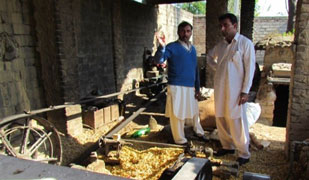 A saw machine powered by the micro-hydro system. A saw machine powered by the micro-hydro system. | 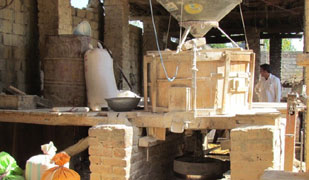 A flour mill powered by the micro-hydro system. A flour mill powered by the micro-hydro system. |
The way forward
Small hydropower projects have enormous scope, potential and opportunities all over Pakistan. According to a study by WAPDA, Pakistan, the Indus basin cascade has a hydropower potential of 60, 000 MW. There is a need to explore these opportunities and undertake effective demonstration and mass awareness campaigns in the communities, but that will need commitment and motivation. The political players and policymakers also need to be informed, through effective strategies, about small hydropower’s potential. There is also a need to overcome the institutional and bureaucratic barriers standing in the way of effective implementation.
With enabling policies, a conducive environment and with the enthusiasm of the communities other similar projects should see success in the region. There should also be serious and sincere efforts to ensure that the projects are economical so that the communities can easily afford them. The technology used and services provided should be easily accessible, and they should be linked with livelihood options.
Using all these learnings, the CAEWRI team is looking forward to working on cost-effective small hydro power systems that will improve the livelihoods of the communities in the region.
